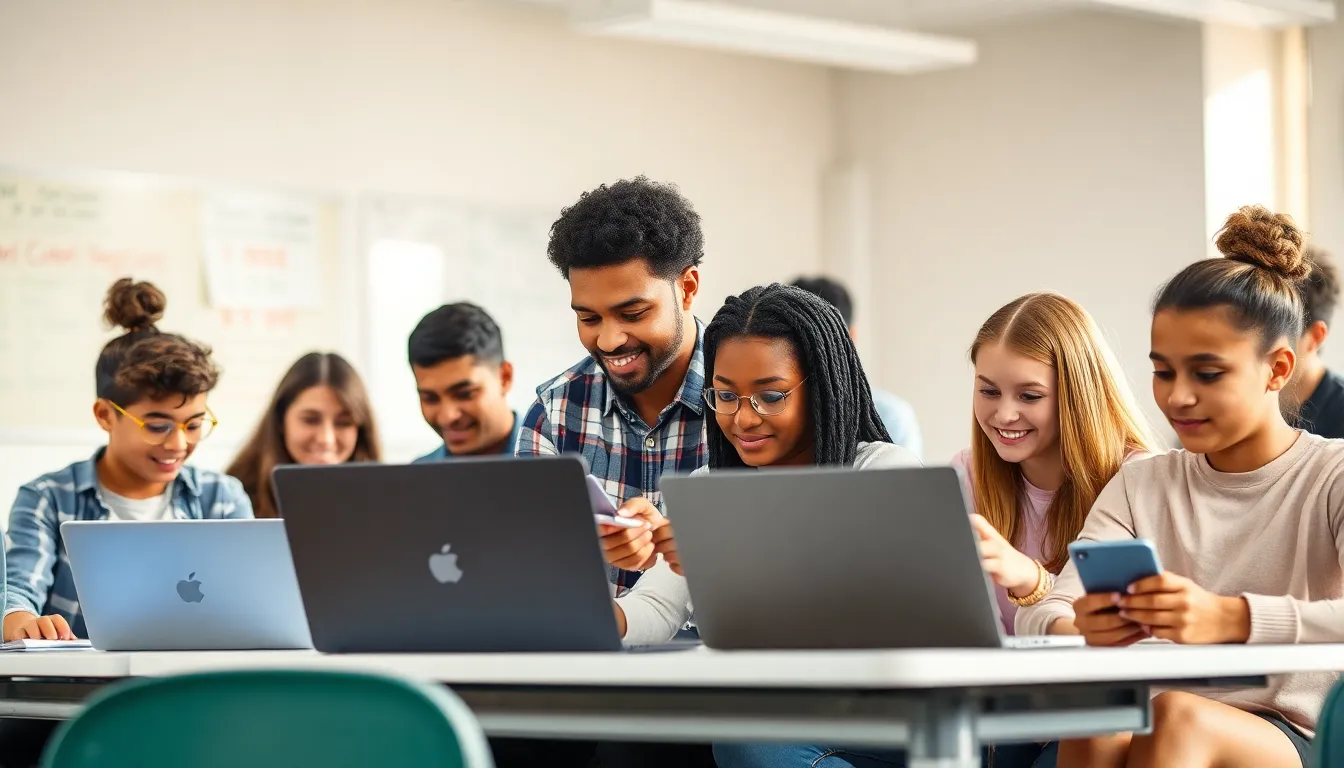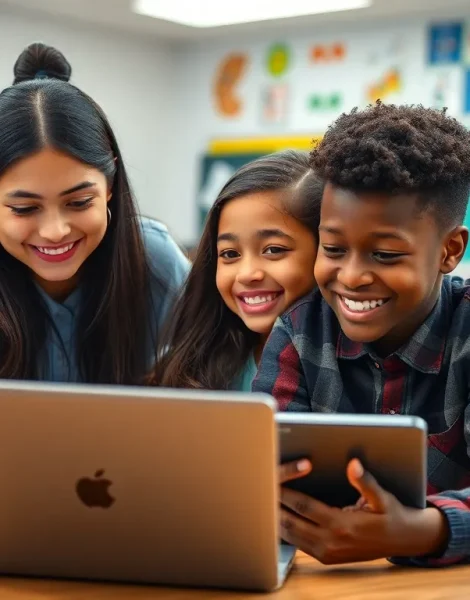In the ever-evolving world of education technology, Google Classroom stands out as a superhero in the classroom. But wait—what’s a superhero without its trusty sidekicks? Enter Google Classroom integrations, the dynamic duo that takes learning from mundane to magnificent. Imagine transforming lessons into interactive adventures, all while keeping students engaged and excited.
Table of Contents
ToggleOverview of Google Classroom Integrations
Google Classroom integrates with various educational tools, enhancing the learning experience for both educators and students. These integrations enable seamless access to applications within the Google Classroom interface, simplifying lesson planning and teaching processes.
Learning management systems, such as Schoology and Edmodo, provide additional layers of interaction. Users can assign work and monitor student progress all in one place.
Content creation tools like Nearpod and Pear Deck make lessons more interactive. Educators can embed quizzes, videos, and interactive slides directly into their Google Classroom assignments.
Additionally, communication tools like Zoom and Google Meet facilitate real-time discussions. These integrations allow for live lectures and group activities, promoting engagement among students.
Assessment tools also integrate smoothly with Google Classroom. Programs such as Quizlet and Kahoot allow educators to create assessments that sync directly with their classroom. Teachers can automatically grade assignments and provide immediate feedback.
Furthermore, extension apps like Kami enhance document annotations and collaborative work. Students can annotate PDFs and collaborate on assignments, enriching their understanding.
Using Google Workspace apps like Google Docs and Sheets improves collaboration and document sharing. Educators can guide students in real time, allowing for dynamic learning experiences.
By leveraging these integrations, educators transform their classrooms into interactive, technology-enhanced environments. Each integrated tool complements the functionality of Google Classroom, crafting a more robust educational experience.
Key Features of Google Classroom Integrations

Google Classroom integrations offer valuable functionalities that significantly enhance the educational experience. These tools not only support collaboration but also help educators manage assignments more efficiently.
Enhanced Collaboration Tools
Enhanced collaboration tools boost student engagement and streamline communication between educators and learners. Apps like Google Meet allow for real-time discussions, fostering connection and interaction. Zoom, another popular integration, provides virtual classrooms that facilitate group projects and discussions. With tools like Kami, document collaboration becomes seamless, enabling multiple users to annotate and edit files simultaneously. These integrations create a more inclusive environment where all voices can be heard. Students benefit from sharing ideas and receiving instant feedback from peers and instructors, ultimately enhancing the learning process.
Streamlined Assignment Management
Streamlined assignment management simplifies the educators’ workflow and improves student accountability. Integrations with learning management systems such as Schoology and Edmodo centralize assignment tracking. Teachers can assign, collect, and grade work more efficiently, saving time and effort. This real-time visibility into student progress helps educators identify areas needing attention. Additionally, tools like Nearpod and Pear Deck make it easy to embed assessments within lessons, ensuring everyone stays engaged. By automating routine tasks, Google Classroom integrations allow teachers to focus on delivering high-quality education.
Popular Integrations for Google Classroom
Google Classroom supports various integrations that enhance teaching and learning experiences. These integrations encompass tools that streamline tasks, foster engagement, and facilitate collaboration.
Google Drive and Docs
Google Drive and Docs integrate seamlessly with Google Classroom, enabling easy file sharing and collaborative editing. Educators can create assignments directly in Docs, allowing students to work on documents simultaneously. Storage options in Drive ensure easy access to resources, while automatic saving prevents data loss. Real-time editing promotes teamwork among students, encouraging them to collaborate on projects. These features simplify the organization of materials, making it straightforward for both teachers and students to manage their work effectively.
Zoom and Video Conferencing Tools
Zoom and other video conferencing tools enhance communication in Google Classroom settings by allowing face-to-face interactions. Integration provides options for scheduling classes and meetings directly within the platform. Teachers can create virtual classrooms for remote learning, ensuring students stay connected. Screen sharing capabilities facilitate discussions, fostering an engaging learning environment. Students can participate actively in real-time, boosting retention and understanding. This integration supports classroom dynamics that mimic in-person experiences, enriching the overall educational experience.
Educational Apps and Extensions
Numerous educational apps and extensions expand the functionality of Google Classroom, making learning more interactive. Tools like Nearpod and Pear Deck embed quizzes and multimedia into lessons, promoting engagement. Extensions enhance the ability to track student progress, provide assessments, and gather feedback efficiently. Integration with platforms like Quizlet helps manage study materials, while Kahoot makes learning fun through gamified assessments. These apps empower educators to tailor content to students’ needs, fostering a more personalized learning experience.
Benefits of Using Google Classroom Integrations
Google Classroom integrations enhance educational experiences by fostering collaboration among students. Increased engagement results from tools like Nearpod and Pear Deck that embed interactive elements into lessons. Communication improves with real-time discussions facilitated by Google Meet and Zoom, making it easier for students to connect.
Streamlined assignment management stands out as a significant benefit for educators. Integrations automate routine tasks, simplifying workflows and boosting student accountability. Assignments become easier to track, allowing teachers to focus on instruction rather than administrative duties.
Access to content creation tools increases customization opportunities for lessons. Teachers can tailor materials to meet diverse learning needs, promoting personalized education. Many educational resources, such as Quizlet and Kahoot, allow for interactive assessments, transforming evaluations into enriching experiences.
Enhanced document collaboration plays a critical role in student learning. Apps like Kami allow students to annotate and share documents seamlessly, encouraging teamwork. Google Drive and Docs support collaborative editing, letting multiple students work together in real-time while saving changes automatically.
The incorporation of educational apps enriches the Google Classroom environment by adding diverse functionalities. These tools not only make learning more interactive but also create pathways for personalized learning experiences. By leveraging these integrations, educators can create digital classrooms that reflect modern learning needs, encouraging deeper engagement and understanding among students.
Challenges and Considerations
Integrating Google Classroom with various educational tools presents challenges that educators must navigate. Compatibility issues often arise, especially when using third-party apps that do not seamlessly connect with Google Classroom. Educators might experience frustration when they encounter technical glitches during implementation, which can disrupt the teaching process.
Data privacy stands as a primary concern. Many integrations require user data, which necessitates compliance with regulations like FERPA. Protecting student information must take precedence when selecting tools, leading educators to carefully assess each integration’s privacy policies.
Training requirements can pose obstacles as well. Some educators may lack the technical know-how to effectively utilize the various integrations. This gap can hinder the overall effectiveness of the tools and limit the enriched experiences that these integrations aim to provide.
Cost implications also factor into decision-making. While many apps offer free versions, premium features often come with a subscription fee. Budget constraints for schools might restrict access to the most effective tools, thereby impacting classroom engagement and productivity.
Learning curves associated with new integrations can slow adoption rates. If students and educators struggle to familiarize themselves with tools like Nearpod or Kahoot, it could impede the intended benefits of those resources. Encouraging ongoing professional development can alleviate this issue.
Monitoring and assessing the effectiveness of integrations is crucial. Educators need to evaluate how well these tools meet learning objectives. Tracking student progress and engagement helps in determining whether to continue using specific integrations or to explore alternatives.
Overall, while Google Classroom integrations hold significant potential, navigating these challenges carefully ensures that they enhance, rather than complicate, the educational experience.
Google Classroom integrations are transforming the educational landscape by enhancing engagement and collaboration among students and educators. These tools not only streamline workflows but also create interactive learning environments that cater to diverse student needs. While challenges such as compatibility issues and data privacy concerns exist, the benefits of these integrations far outweigh the drawbacks.
By leveraging the right tools, educators can foster a more dynamic classroom experience that promotes personalized learning. Embracing these integrations allows teachers to focus on what truly matters: inspiring students and enriching their educational journeys. With ongoing professional development and careful monitoring, the potential of Google Classroom integrations can be fully realized, making education more effective and enjoyable for everyone involved.








